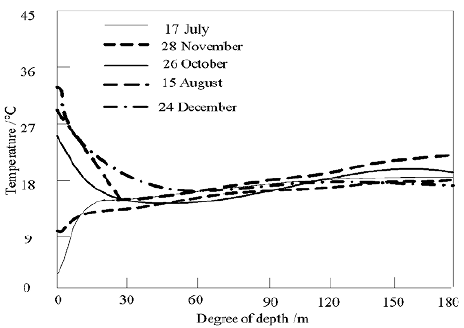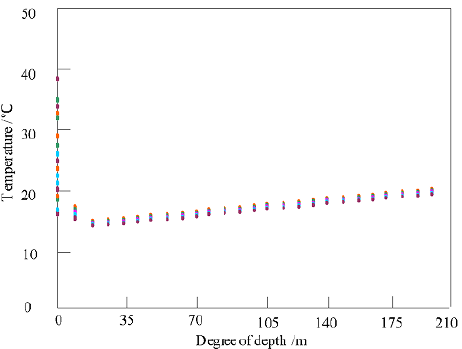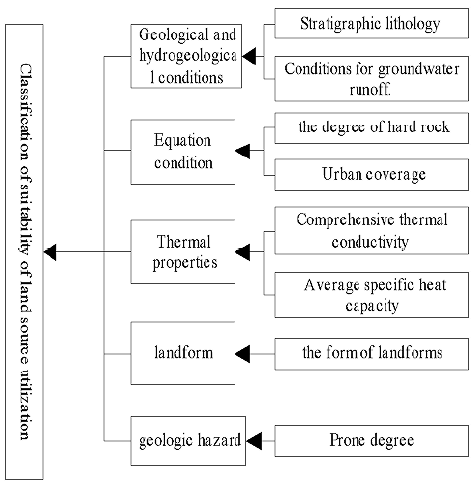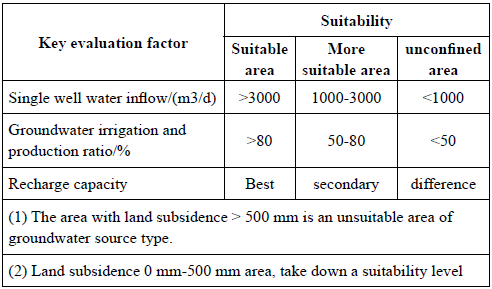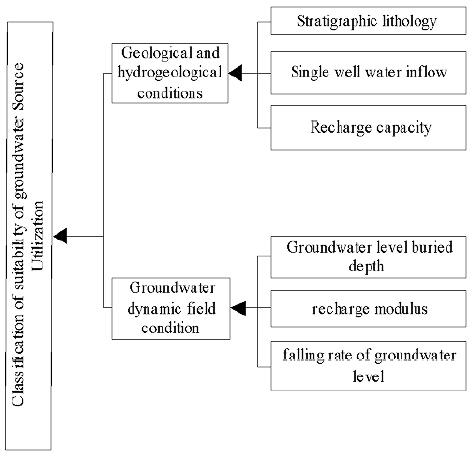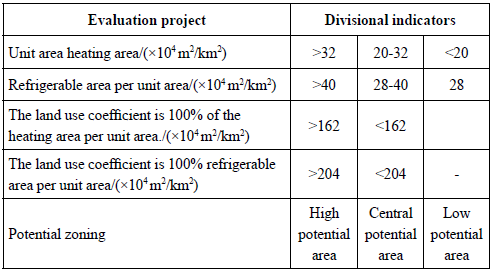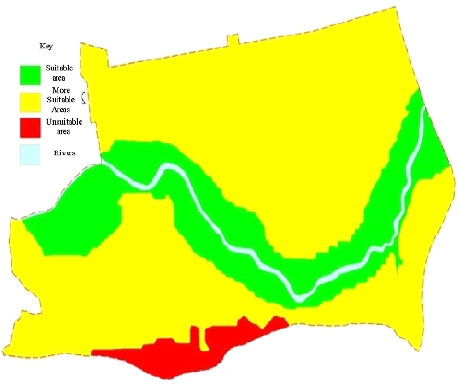Introduction
Energy problems, environmental, and sustainable development issues always trouble all over the world. The extensive energy use consumes a large number of non-renewable energy sources such as coal and oil. But those resources are expensive. Energy has become a bottleneck restricting sustainable development (Liu & Nasr, 2019). People have paid more and more attention to energy conservation, new energy development, environmental pollution reduction, and sustainable development. All countries are trying to find and develop environmental, renewable energy. China is also facing the same problem (Wang et al., 2017). As a renewable, environmental, clean energy resource, the shallow geothermal energy resource has been gradually recognized, accepted and valued in recent years in China (Neupane et al., 2016). The shallow geothermal energy is a new member of the geothermal renewable energy family. It is also another form of solar energy, widely in the surface layer of the earth (thermostat layer). It can be recovered and renewable, and it is inexhaustible low-temperature energy (Zhang & Hu, 2018).
The shallow geothermal energy is a low-temperature geothermal resource in the rock and soil of the earth's surface; it is also an essential part of thermal energy. It is a clean, renewable resource with abundant reserves, wide distribution, and stable temperature. Its development and utilization play an essential role in energy saving, emission reduction, and environmental protection. Its development and utilization prospects are broad (Zhang et al., 2017). Currently, the development of technology is mature, which has been widely applied in heating and cooling. It is a good alternative energy and clean energy. With the gradual popularization of ground source heat pumps, the utilization of shallow geothermal energy has attracted more and more attention, which has become a new growth point of geothermal energy utilization. Due to the excessive growth of demand in the area where the ground source heat pumps are popularized, the application of this technology shows a blind and disorderly development trend, ignoring the hydrogeological condition of the application site to a large extent, leading to the waste of groundwater resource and the inefficiency of the heat pumps (Mihoub et al., 2016).
To solve these problems objectively and ensure the rational development and utilization of shallow geothermal energy, we not only normalize the heat pump market but also investigate and evaluate the shallow geothermal resource according to the hydrogeological conditions, regional development and energy demand. We should scientifically carry out the suitability zoning of ground source heat pumps' application and make reasonable development, and utilization plans to determine favorable development regions and appropriate development and utilization methods. All this to achieve orderly development, rational use and scientific management of shallow geothermal energy resources. These can provide a scientific basis for the macro decision-making on unified planning, improving energy efficiency and ensuring energy security (Michopoulos et al., 2016). Therefore, it is necessary to establish a model for evaluating the adaptability of ground source heat pumps. The standardized and systematic evaluation of shallow geothermal energy is critical. It is essential to organize them with various hydrogeological conditions for unified management. After considering the factors influencing the spatial distribution of shallow low-temperature energy, the standard way is challenging to achieve timely, effective management. Therefore, an evaluation model for shallow geothermal resources development potential should be constructed (Zhang et al., 2016).
Some relevant literature shows that many scholars have studied it. Liu Licai has divided the suitability of water source heat pumps in the planning area of Beijing. Wang Yabin has partitioned the suitability of hydrogeological conditions of the water source heat pump system in Tianjin. Wang Tao evaluated the suitability of shallow geothermal energy utilization in key cities along the Yellow River economic belt in Ningxia. Generally, China is still in the early stage due to its short development time. The unbalanced development and some problems need to be studied and solved urgently. Otherwise, it will directly affect the development and sustainable utilization of shallow geothermal energy resources. In conclusion, there are many complex methods for evaluating the suitability of shallow geothermal. There is no specific mature method theory. Some scholars directly use the method of artificial qualitative zoning to make the zoning intervals for the values of each element, and then corresponding suitability zoning is carried out. This method is too subjective, which is not scientific and reasonable enough. Some scholars use programming or software for the subarea. Although this method is efficient, it is not flexible enough.
Meanwhile, the results are usually complex, and its practicability is too low. On this basis, this paper uses the analytic hierarchy process (AHP) to divide the suitability of development and utilization. After that, the evaluation model is used to evaluate the development potential of shallow geothermal resources based on the zoning (Alkhasov et al., 2016).
Material and Method
Depth and Temperature of the Constant Cone of Subsurface Temperature
Because the geothermal characteristics of different regions are different, this paper takes Weinan City as an example to research. In order to analyze the relationship between the depth and temperature of the layer of constant temperature in Weinan, eight wells of different geomorphic units in this region (six of them are the engineering geological exploration holes, two of them are motor-pumped wells) are monitored numerically with the depth of water temperature (if the water temperature is close to the formation temperature, the measured water temperature is substitute for the ground temperature). In the thermal response test construction, a U-shaped pipe is embedded in the borehole, and water is injected to ensure the tightness. The U-tube can be used for future temperature tests, and the digital temperature measurement single cable multi-probe detection system is adopted. The actual construction proves that when the stratum temperature changes slowly, it is accurate in any depth (Zhou et al., 2017). The geothermal change curve and the scatter plot of the relationship between geo-temperature and depth in Weinan are obtained by corresponding technology. The geothermal change curve is shown in Figure 1. The scatter plot corresponding to the relationship between ground temperature, and depth is shown in Figure 2.
From the variation curve of ground temperature, we can see that the ground temperature of each monitoring hole in the depth of 0m-15 m underground varies with the rise and fall of temperature in different seasons. The seasonal variation of ground temperature is evident. The ground temperature in the depth of 15 m-20 m underground is basically constant, and the ground temperature is 15°C-17°C. The ground temperature of each monitoring hole at the same depth does not change with the season when the depth is below 20 m. The ground temperature in different seasons is basically unchanged, and the temperature increases linearly with the increase of burial depth (Bisht & Rupenthal, 2016).
Geothermal Variation Characteristic at Vertical Direction
According to the data of eight geothermal monitoring points in different geomorphic locations, the geothermal field within the region generally increases with the depth at the vertical direction, but the geothermal changes vary in different depths. In the normal temperature zone (15 m-25 m), especially the near-surface area of 0 m-3 m, the ground temperature is affected by seasonal climate change, and the fluctuation is sensitive. Moreover, the influence of climate change on the ground temperature between 3 m and 15 m decreases gradually. Under the normal temperature zone of about 25 m, the ground temperature has not been influenced by local climate change. The temperature increases with depth. The ground temperature is19.8°C-22.0°C when the depth is 200 m. The average geothermal gradient is 1.18/100 m to 3.57/100 m. Based on the monthly average water temperature at different depths of eight long-term observation wells, the variation curves of ground temperature in various depths and different periods (the water temperature below groundwater level is the same as the ground temperature) with depth are drawn to analyze the vertical variation characteristics of ground temperature in natural state. According to the curve, the vertical geothermal distribution feature in the research area belongs to the linear gradual rising type. Under 20 m, the ground temperature of each observation hole at different depths does not change significantly with the seasons. With an increase of depth, the ground temperature increases linearly. The change of ground temperature in Qianlu Waterworks (WN178) is the largest, from 40m to 180m. As the ground temperature increases by about 5°C and the geothermal gradient is about 3.57°C/100 m. The changing trend of ground temperature in Zhang yicun (WG001) is relatively slow, from 30m to 100m. The ground temperature increases by about 0.81°C, and the geothermal gradient is 1.18°C/100 m. In the stratum warming zone, the geothermal temperature is controlled by deep geothermal warming, and the geothermal temperature gradually increases with depth. Due to the influence of geological structure, groundwater activity, and stratum rock characteristics, vertical geothermal warming varies from place to place. It is concluded that the geothermal temperature in the research area changes with depth. The features are mainly influenced by the geological structure and groundwater activity (Ruelle et al., 2016).
Geothermal Horizontal Distribution Characteristic
Generally, the ground temperature in 100 m buried depth is high in the south and low in the north. There is a geological fault in the front of the second terrace on the south bank of Weihe River. The ground temperature in the 100m buried depth of the third terrace on the south of fault can reach 19.1°C. The main reason is that the basement faults are mature in the area, conducive to the heat conduction from deep to shallow. The distribution direction of the third terrace in the south of Weihe River is consistent with the underlying fault structure. According to the contour maps of ground temperature and average geothermal gradient at 100 m depth, the geotemperature is abnormal if the geotemperature is higher than 17.5°C; and the average geothermal gradient is higher than 3°C/100 m. It can be seen that the geothermal anomaly regions are zonally distributed in the second and third terraces of Weihe River in the southern part of Weinan, and the average geothermal gradients are mostly concentrated in the range between 3.0°C/100 m-3.35 °C/100 m. The basement faults in the southern part of Weinan are mature (Czycholl et al., 2017), mainly influenced by the faults in the south bank of the F1 Weihe River. It is affected by the faults in front of the tableland of the F2 Weihe River and F3 Zero River faults. In addition, two ground fissures are developed in the southern part of Weinan and the trend is east-west, which are roughly parallel to the faults. The fault structure in this area is conducive to heat conduction from deep to shallow. The direction of geothermal anomaly is consistent with that of underlying fault structure. At present, the exploitation of shallow geothermal energy in Weinan is relatively low. No one wants to exploit and utilize the geothermal anomaly area.
Principle and Method of Suitability Zoning
The suitability zoning of shallow geothermal energy development and utilization runs through the research. Its purpose is to provide the basis for the selection of development and utilization mode, resource evaluation and development and utilization planning.
(1) Zoning principle is based on the geological and hydrogeological conditions. The geological conditions are the important basis for the occurrence of shallow geothermal energy, and the hydrogeological conditions are the main influencing factors for the occurrence of shallow geothermal energy. For the purpose of development and utilization of shallow geothermal energy, the reasonable development and utilization mode and the effective heat pump system are the important media. We need to focus on both economic benefits and environmental protection. Under the current technological and economic conditions, regions and ways with relatively good economic, environmental and energy-saving effects should be selected for the development and utilization of shallow geothermal energy. The plane division and vertical control should be combined. The range of plane zoning areas is the long-term planning area of urban construction in 2020. The overall evaluation control depth is 200 m.
(2) Zoning method: it is necessary to closely combine with the conditions of shallow geothermal energy in this area. Firstly, the necessary conditions of suitability are divided by key factor method, and then the suitability level is divided by analytic hierarchy process (AHP) and comprehensive index method respectively. The analytic hierarchy process (AHP) is a qualitative, systematic and hierarchical analysis method. It has practicality and effectiveness in processing complex decision-making problems. The comprehensive index method refers to the comprehensive evaluation index which uses the weight calculated by the analytic hierarchy process and the numerical value obtained by the fuzzy evaluation method to put forward the economic benefit index. The more influential factor on suitability division will be more important. By establishing the comparison matrix, we can check the consistency of comparison matrices and adjust the comparison matrix if necessary, so as to achieve acceptable consistency. According to the occurrence condition of shallow geothermal energy, it can be divided into three development and utilization modes: ground-source type (buried pipe), groundwater-source type and surface-water source type, and then we can divide them into different suitable areas. Ground source types can be divided into five types: favorable area, suitable area, general area, undesirable area and unsuitable area. Among them, suitable area can be divided into three sub-areas: loose rock subregion, semi-consolidated rock subregion and consolidated rock subregion (Winters et al., 2016). The groundwater source can be divided into three types: favorable area, suitable area and unsuitable area. The surface water source can be divided into two types: suitable area and unsuitable area.
Suitability Zoning Evaluation System of Ground Source
The geological and hydrogeological conditions, construction conditions, thermophysical properties, topography, geomorphology, environmental geological problems are chosen as the attribute-level indexes for the evaluation of suitability zoning of development and utilization of geo-source type. Where, the thickness of the loose layer, the probability of geological hazards and the topography are the key factors. On the premise of determining the key factors, the method of analytic hierarchy process and the method of comprehensive index are used to divide the development and utilization suitability zoning of shallow geothermal energy of ground source type. As shown in Figures 3 and Figure 1:
Table 1 Selection table of crucial factors of suitability
| Suitability | Partition key factor |
|---|---|
| Suitable area | An area with loose layer thickness greater than 100 m |
| lower area | Semi-consolidated rock area |
| General suitable area | Geological hazard (collapse, landslide, debris flow, karst ground collapse) low-prone area, and loose layer thickness of 30 m-50 m |
| Difference suitable area | Geological hazards (collapse, landslide, debris flow, Karst ground collapse) in prone areas, middle hills and above geomorphologic units |
| unconfined area | Geological hazard (collapse, landslide, debris flow, karst ground collapse) high-prone area |
From Figure 3, we can see that the structure of suitability division of development and utilization of geo-source type is mainly based on the geothermal characteristic. By considering the hydrogeological condition, equation condition, thermal physical property, topography, geological hazards and other factors, we can divide the suitability of development and utilization of geo-source type. Meanwhile, it can be seen that the suitability can be divided into five categories (Yan & Xu, 2016).
Subarea Evaluation System for Suitability of Groundwater Source
The groundwater abundance and groundwater dynamic field conditions are selected as attribute-level indexes for the suitability evaluation of groundwater source. The six indexes such as single-well water inflow, effective thickness of aquifer, recharge capacity, water level burial depth, water level descent rate and recharge modulus are selected as element layers of the hierarchical analysis. Where, the groundwater richness, the recharge capacity and environmental geology are the key factors (Li et al., 2016). On the premise of determining the key factors, the method of analytic hierarchy process and the comprehensive index are used to divide the suitability of development and utilization of shallow geothermal energy of groundwater sources.
From Figure 4, the division structure of suitability of development and utilization of groundwater source is mainly based on the geothermal characteristic. After considering the geological condition, hydrogeological condition and groundwater dynamic field condition, the suitability of groundwater source can be divided by above factors. Meanwhile, the key evaluation factors of suitability division of groundwater source development and utilization mainly include the number of single well users, groundwater irrigation-production ratio and recharge capacity. According to above evaluation factors, the suitability evaluation of groundwater source development and utilization can be achieved.
Zoning Assessment System for Suitability of Surface Water Source
The development and utilization of surface water source shallow geothermal energy can be divided into two types: separated type and closed type. The evaluation indexes of suitability of surface water source type mainly include the recyclable amount of surface water, water depth, water temperature, water quality and distance from the project.
From Table 3, we can see that the evaluation indexes of development and utilization of surface water resource mainly include five evaluation indicators: volume, water quality and depth in dry season. The suitability of surface water resources development and utilization can be divided by the degree of conformity of development and utilization of surface water resources to these indicators (Wen & Fang, 2018).
Table 3 Classification of suitability for development and utilization of surface water source types
| Utilization mode | open | closed |
|---|---|---|
| Volume during dry season/(x104m3) | >20 | >20 |
| water quality | Meet the requirements of the specification | Meet the requirements of the specification |
| Water depth in dry season/m | >3 | >3 |
| Coldest monthly mean water temperature | >10 | >5 |
| Distance between utilization engineering and water source/km | <0.5 | <0.5 |
| Comprehensive evaluation standard of suitability | It is appropriate to meet the five indicators |
Evaluation of Tap Potential of Shallow Geothermal Energy Resource
The evaluation for development potential of shallow geothermal resources includes the evaluation of shallow geothermal capacity and heat-exchange power. Based on the zoning results, the evaluation index of shallow geothermal resource development potential is selected at first, and then the development potential of shallow geothermal resource is evaluated by the evaluation index.
Heat Capacity
The shallow geothermal energy capacity is the unit temperature difference heat stored in shallow rock, soil and groundwater. The thermal storage method is adopted. The depth range is 200 m. The calculated area is the suitable area.
In the formula, Qr is the geothermal energy capacity. Q s is the energy capacity in rock and soil. Q w is the energy capacity ofwater contained in rock and soil (Sowizdzal, 2016). Q A is the energy capacity of air contained in rock and soil. The formula for calculating the energy capacity of rock and soil is as follows:
In the formula, p s is the density of rock and soil. C s is the specific heat capacity. <p is the porosity. M is the area. dis the thickness of rock and soil are considered (Al-Samari & Ali, 2018). The formula for calculating the energy capacity of water in rock and soil are as follows:
In the formula, ρ w is the water density. C W is the specific heat capacity. ω is the water content of rock and soil. The formula for calculating the energy capacity of air in rock and soil are as follows:
In the formula, ρ A is the air density. C A is the specific heat capacity of air. According to the main rock character of the aquifer, the depth of the Quaternary base boundary and the depth of shallow groundwater, this region is divided into 148 sub regions. According to the difference of area conditions, the sub regions are merged into 18 evaluation units. According to the main rock character of aquifer, they are divided into three areas, and then we calculate them.
Heat-exchange Power of Groundwater Source Heat Pump System
The heat-exchange power of groundwater heat pump systems is calculated by groundwater demand conversion method. The calculation process is as follows:
In the formula, Q q is the heat-exchange power of shallow geothermal energy in the evaluation area. Q h is the heat-exchange power of shallow geothermal energy of a single well. n is the number of drillable holes in the calculation area. * is the land usage rate. The formula for calculating the heat-exchange power of shallow geothermal energy of single well is as follows:
In the formula, Q h is the heat-exchange power for a single well. q w is the amount of groundwater recycling utilization. ∆t is the difference in temperature for groundwater utilization. p w is the density of water, 1000 kg/m3. C w is the specific heat capacity of water, 4.18 kJ/(kg°C).
Heat-exchange Power of Buried Tube Heat Pump System
According to the heat-exchange power of the ground-coupled heat pump, the unit heat transfer method (Fu, 2018) is adopted. The calculation process is as follows:
In the formula, Q K is the heat-exchange power of shallow geothermal energy, and q k is the heat-exchange power of shallow geothermal energy per unit area. M is the calculation area.
Establishment of Shallow Geothermal Energy Potential Evaluation Model
According to the heat-exchange power of ground source heat pump system and the indexes of heating in winter and cooling in summer, the area for heating and cooling of suitable and more suitable regions of groundwater ground source heat pump in winter and summer was further calculated, and then the resource potential of ground source heat pump system (Zhang et al., 2018) is obtained. The detailed formulas are as follows:
In formulas, m is the heating/cooling area of groundwater/buried pipe ground source heat pump system. Q q is the heat-exchange power in the suitable region and the more suitable region of groundwater/buried pipe ground source heat pump system. q is the heating index in winter and the refrigeration index in summer. Q zq is the resource potential of groundwater/buried pipe ground source heat pump system. m is the heating/refrigerating area of groundwater/ buried pipe ground source heat pump system. M is the area of the calculation region. Through the above formulas, the index table of potential evaluation zoning is obtained.
On the basis of the above analysis, the development potential of shallow geothermal energy resources can be evaluated by the above table.
Results
In order to verify the validity of the evaluation method, the proposed method is used to analyze the occurrence condition of shallow geothermal energy in Weinan city and the characteristic of geotemperature in Weinan city. It evaluates the suitability of development and utilization and the heating/ cooling potential of groundwater ground source heat pump system and buried pipe ground source heat pump system. The heat capacity of shallow geothermal energy is calculating. The environmental benefits and economic benefits of shallow geothermal energy development are discussed. The detailed analysis process is shown below.
Suitability Zoning of Groundwater Ground Source Heat Pump
In order to research the suitability zoning effect of groundwater ground source heat pump of the proposed method, a practical experiment is carried out. The results of the practical adaptability zoning are shown in Figure 5. The area and percentage of each region after the zoning are shown in Table 5.
Table 5 Statistical table of suitability zoning and area of groundwater ground source heat pump
| Suitability zoning | Real area /km2 | Percentage |
|---|---|---|
| Suitable area | 36.49 | 11.69 |
| More suitable area | 153.61 | 49.24 |
| General suitable area | 95.48 | 30.61 |
| Difference suitable area | 10.62 | 3.4 |
| Unconfined area | 12.56 | 4.03 |
| Unevaluated area | 3.21 | 1.03 |
| Total | 311.97 | 100 |
From the charts, we can see that the suitability of groundwater source heat pumps is obviously different due to the difference of hydrogeological characteristics. The suitability can be divided as follows. The suitable region of groundwater source heat pump: it is distributed in the mid-Weihe floodplain of the evaluation region. The rock character of aquifer is composed of gravel, gravel-bearing medium-coarse sand and silty clay. The stratum has good water conductivity, including double-layer phreatic water-confined water. The water-abundance is good. The unit water inflow is 10 m3/hm-30 m3/hm. Therefore, it is suitable for groundwater pumping. The area of this region is 61.14 km2, accounting for 22.23% of the total area of the evaluation area. The suitable region of groundwater source heat pump: it is distributed in the first terrace on the north bank of Weihe River, the terrace on the south bank of Weihe River and the alluvial-proluvial fan region. The rock character of aquifer is Quaternary Holocene Alluvion, including the gravelly sand, medium sand, coarse sand, silt and silty clay. The groundwater pumping condition in this area is relatively good, the water abundance is medium-weak, the unit inflow is 1 m3/hm-10 m3/hm. The area is 196.60 km2, accounting for 71.48% of the total area of the evaluation area. The unsuitable region of groundwater source heat pump: it is mainly distributed in the third terrace covered by loess in the south evaluation region. The stratum lithology is mainly Pleistocene Aeolian Loess and silty clay with little thin sandy soil. The water abundance of groundwater in this region is weak, and the water conductivity is poor. The unit water inflow is 1 m3/hm-5 m3/hm, which is not suitable for the project of groundwater source heat pump. The unsuitable area of groundwater source heat pump is 10.93 km2, accounting for 3.98% of the total area of the evaluation area. The unevaluated area is Weihe River, namely the existing river in the evaluation area, with an area of 6.37 km2, accounting for 2.32% of the total area of the evaluation region.
Heat Exchange Power and Potential of Groundwater Ground Source Heat Pump
In order to study the validity of calculation and evaluation for the heat-exchange power and potential of groundwater ground source heat pumps in Weinan City, it is necessary to carry out practical analysis. The analysis results are shown in Table 6.
Table 6 Heat transfer power and potential of groundwater ground source heat pump
| Zoning and numbering | Zhao Zhai-Li Jia Wan | Longjiang Town-Hantai District-Pu Zhen | Liangshan town | Zhongsuo town-Dahekan town | Sujiashan Village | Total |
|---|---|---|---|---|---|---|
| Zonal area/km2 | 21.95 | 94.37 | 15.33 | 13.24 | 0.33 | 145.22 |
| Suitability | More suitable | Suitable | Suitable | Suitable | More suitable | |
| Winter heat transfer power/kW | 8.83x104 | 1.21x106 | 2.67x105 | 2.32x105 | 1.16x103 | 1.17x106 |
| Summer refrigeration power/kW | 1.76x105 | 2.42x106 | 5.34x105 | 4.62x105 | 2.32x103 | 3.58x106 |
| Winter heating potential/ (m2/km2) | 5.39x104 | 1.72x105 | 2.33x105 | 2.35x105 | 4.68x104 | 1.48x105 |
| Summer Refrigeration Potential/(m2/km2) | 7.77x104 | 2.48x105 | 3.36x105 | 3.38x105 | 6.74x104 | 2.13x105 |
From Table 6, the total area of suitable and more suitable regions of groundwater source heat pump in this area is 145.22 km2, and the total heat transfer power of groundwater source heat pump system is 1.17x106 kW (winter)/ 3.58x106 kW (summer). When using the groundwater ground source heat pump system to develop and utilize the shallow geothermal energy, the average heating potential in winter is 1.48x105m2/km2, and the average refrigeration potential in summer is 2.13x105 m2/km2.
Heat Exchange Power and Potential of Buried Tube Ground Source Heat Pump
In order to study the validity of this method in calculating and evaluating the heat-exchange power and potential of ground source heat pump, it is necessary to take the average temperature of fluid in the buried pipe of Weinan City in winter and summer as 6°C and 32°C respectively. The heat-exchange power potential of the ground source heat pump system in Weinan City is calculated and evaluated by the proposed method. The results obtained by the proposed method are as follows.
Table 7 shows that the heat-exchange power in winter and summer is 1.04x107 kW and 1.26x107 kW respectively. The average heating potential in winter is 9.64x105 m2/km2 and the average refrigeration potential in summer is 1.18x106 m2/km2 when using the ground source heat pump system to develop and utilize shallow geothermal energy.
Table 7 Calculation table of heat transfer power meter potential of a ground source heat pump with buried pipe
| Zoning and numbering | Praise canal | Longjiang Town-Qili Town-Paving Town | Liangshan Town-Belt floodplain on the South Bank of Hanjiang River | Floodplain on the east bank of Lianshui River | Floodplain east of Dahekan town on the south bank of Hanjiang River | The first - class terrace south of Liangshan Town | Huilong Temple-Yuying Village | Total |
|---|---|---|---|---|---|---|---|---|
| Zonal area/km2 | 3.36 | 112.69 | 6.04 | 1.26 | 2.36 | 9.29 | 9.94 | 144.94 |
| Suitability | More suitable | Suitable | Suitable | Suitable | Suitable | More suitable | More suitable | |
| Winter heat transfer power/kW | 2.75x105 | 7.93x106 | 4.60x105 | 1.02x105 | 1.98x105 | 6.98x105 | 7.54x105 | 1.04x107 |
| Summer refrigeration power/kW | 3.34x105 | 9.61x106 | 5.59x105 | 1.23x105 | 2.41x105 | 8.48x105 | 9.12x105 | 1.26x107 |
| Winter heating potential/(m2/km2) | 1.09x106 | 9.44x105 | 1.01x106 | 1.09x106 | 1.12x106 | 1.03x106 | 1.02x106 | 9.64x105 |
| Summer Refrigeration Potential/(m2/km2) | 9.59x105 | 8.24x105 | 8.92x105 | 9.47x105 | 9.83x105 | 8.83x105 | 8.89x105 | 1.18x106 |
Analysis of Resources Development Potential
In order to verify the accuracy of the proposed method in evaluating the development potential of shallow geothermal energy, it is necessary to carry out actual experimental analysis. Weinan City is divided into three regions. Finally, the evaluation results as shown in Table 8.
Table 8 Evaluation of Development Potential
| Partition number | I | II | III | Average |
|---|---|---|---|---|
| Zonal area/km2 | 143.02 | 114.76 | 10.89 | 268.67 |
| Suitability | Both land source and water source are suitable or more suitable | Both land source and water source are suitable or more suitable | Only the ground source is suitable or more suitable. | |
| Considering the heating potential of Land use coefficient in Winter/(m2/km2) | 2.68x105 | 2.04x105 | 1.54x105 | 2.36x105 |
| Consider the potential of land use coefficient for summer refrigeration/(m2/km2) | 3.43x105 | 2.62x105 | 1.95x105 | 3.03x106 |
| Heating potential in winter when land use efficiency is 100%/(m2/km2) | 1.37x106 | 1.48x106 | 1.55x106 | 1.43x106 |
| Summer Refrigeration potential when Land use efficiency is 100%/(m2/km2) | 1.75x106 | 1.88x106 | 1.96x106 | 1.82x106 |
| Potential division | Central potential area | Low potential area | Low potential area |
From Table 8, we can see that land use coefficient has a great influence on the potential of ground source heat pump systems. Meanwhile, most of the floodplain areas in Weinan are high potential areas of ground source heat pumps. The water level in the area is shallow and the effective aquifer is thick. The comprehensive heat transfer coefficient is high and single-hole heat exchange power is large. The ground source heat pump system has large heating/ cooling potential in winter and summer. The area is 50.79 km2, accounting for 18.47% of the total area. The first-order region of Weihe River within the zoning area is the middle potential area of ground source heat pump, with an area of 135.74 km2, accounting for 49.35% of the total area. The built area of Weinan has small land use coefficient and low potential of ground source heat pump system, which belongs to the low potential area of ground source heat pump. The area is 82.14 km2, accounting for 29.86% of the total area.
Through actual investigation and analysis, we can see that the evaluation results of the proposed method are in good agreement with the actual results. Therefore, the evaluation accuracy of the proposed method is higher.
Discussions
There are many ways to exploit the shallow geothermal energy resource. The groundwater ground source heat pump and buried pipe ground source heat pump are the two main ways. The groundwater source heat pump system consists of groundwater heat-exchange system, computer room system and terminal system. The working principle of the ground water source heat pump system is to pump groundwater and exchange heat through a ground source heat pump unit or plate heat exchanger. In winter, all the low-temperature water pumped from underground water after heat exchange through a ground source heat pump unit is recharged into the same aquifer, and the heat quantity is used for the building heating and domestic hot water. In summer, all the high-temperature water is recharged into the same aquifer after the heat exchange of pumped groundwater through a ground source heat pump unit or plate heat exchanger. At the same time, the high-temperature water can be exchanged through a heat pump unit to provide domestic hot water. The characteristics are as follows: at suitable sites for sinking a well, a certain number of pumping and irrigation wells are drilled, and heat is absorbed or discharged from groundwater by recycling, so that the number of wells and the area are few. The heat-exchange way of the underground heat-exchange system is mainly the thermal convection, and the temperature of groundwater is basically constant throughout the year. The initial cost is lower than that of a buried pipe ground source heat pump system. Under appropriate groundwater depth, COP is higher and the operation cost is lower.
The buried-pipe ground source heat pump system is similar to the groundwater ground source heat pump system. It consists of a heat exchange system with buried pipe, computer room system and terminal system. The working principle of the buried-pipe heat exchange system: the heat transfer medium circulates in the sealed vertical or horizontal buried pipe, and then the temperature difference among the heat transfer medium, the underground rock and soil and the groundwater is used to exchange heat, so that the purpose of utilizing the shallow geothermal energy can be achieved. Meanwhile, the heating and cooling of buildings and domestic hot water through heat pump technology can be realized. The features are as follows: the project needs to drill many boreholes according to the cold load and heat load, and sets a closed circulating pipe with certain strength, corrosion resistance and good heat transfer performance, and then uses the circulating liquid to exchange heat, so as to connect all circulating pipes. Finally, it enters the computer room and main engine. The buried-pipe ground source heat pump (GSHP) system is based on the fact that the temperature of underground rock and soil and groundwater remains constant throughout the year. If the vertical buried tube heat exchanger is used to conduct and absorb heat between underground rock and soil and groundwater, the heat exchange efficiency is lower than that of groundwater ground source heat pump systems. Compared with traditional air-conditioning systems and groundwater ground-source heat pump systems, the main disadvantage of buried-pipe ground-source heat pump systems is high initial investment of ground-source heat exchangers. The heat exchanger of a ground source heat pump system with a buried pipe occupies a larger area than that of the pumping well of an underground water source heat pump system. The ground source heat pump system does not draw water from the ground. Theoretically, the ground source heat pump system with buried pipe has less impact on the environment of underground space than that of groundwater source heat pump, and its procedure is simpler. Therefore, the ground source heat pump system with buried pipe has the characteristics of green environmental protection, high efficiency and energy saving, low operation cost, mature technology, wide application range (it is applicable to any stratum and building). In addition, it does not need to pump the groundwater.
Conclusions
The evaluation of shallow geothermal energy development potential is an effective technology for rational planning of urban layout, protection of shallow geothermal resources and sustainable development and utilization of shallow geothermal resources. Based on the analysis of the geotemperature characteristic in Weinan, this article achieves the suitability zoning of comprehensive development of groundwater source heat pump, buried pipe ground source heat pump and shallow geothermal energy according to the requirements of analytic hierarchy process. Meanwhile, this article uses the shallow geothermal capacity, heat-exchange power and resource potential to quantitatively evaluate the research region. The total area of suitable and more suitable regions of groundwater ground source heat pump in Weinan is 145.22 km2. When using groundwater ground source heat pump systems to develop and utilize the shallow geothermal energy, the average heating potential in winter is 1.48x105 m2/km2, and the average refrigeration potential in summer is 2.13x105 m2/km2. The potential middle area of ground source heat pump in Weinan is 135.74 km2, accounting for 49.35% of the total area, while the potential low area of ground-source heat pump in Weinan is 82.14 km2, accounting for 29.86% of the total area. The result and the amount of available resources directly reflect the prospects and potential of shallow geothermal energy development and utilization in Weinan.













